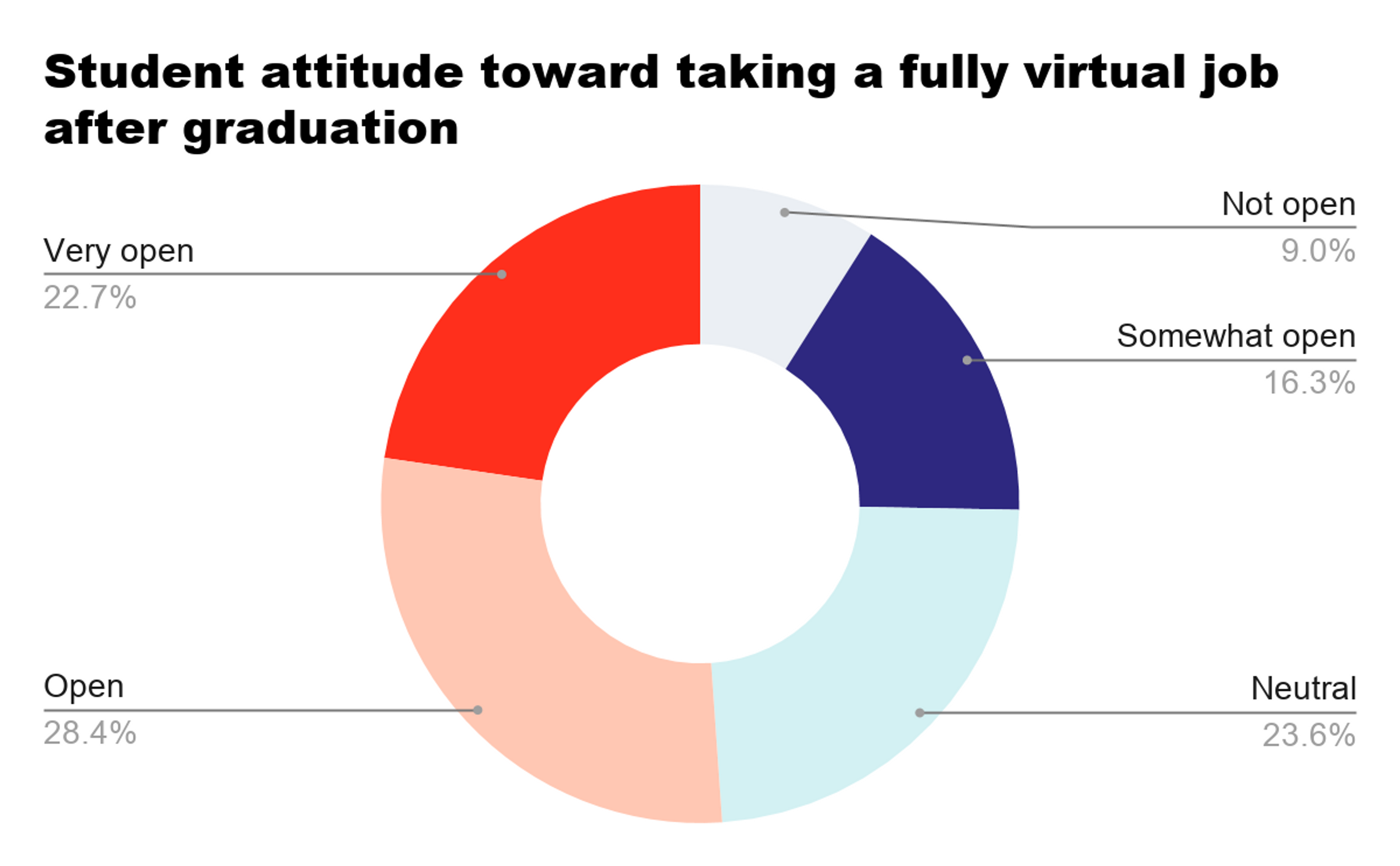In late July, Handshake surveyed career services leaders about the effects of COVID-19 on their work and plans for the coming year. 574 respondents from every cohort in higher education responded with their priorities for the fall and predictions about the year to come.
The results find career services professionals reflecting three major themes:
- What are the changes career centers perceive in their student population and how do they predict students will be affected long term in their career journey by COVID-19?
- How are career services leaders and teams being affected by the financial hardships anticipated by institutions?
- How will the current circumstances affect the future of the education-to-employment pathway?
PART 1: THE SHIFT TO VIRTUAL
Career Center leaders are focused helping their staff work remotely, while keeping institutional leadership aware of their value.
Aside from the health of their staff, the highest priority of career centers within almost all higher ed cohorts has been helping career center staff switch to working remotely, followed by keeping institutional leadership aware of the career center’s value in light of shifting financial news during COVID-19.
Top Five Priorities for Career Center Operations during COVID-19
- Helping my career services team transition to working remotely.
- Keeping institutional leadership aware of the career center’s value in light of shifting financial news.
- Preparing potential scenarios for my career center that involve furloughs, budget cuts, and/or layoffs.
- The professional development and satisfaction of career center staff
- Maintaining and/or finding new sources of career center revenue
Community Colleges were the only cohort to deviate from the above, ranking the need to keep institutional leadership aware of their value as their highest priority, followed by helping staff switch to working remotely.
The Student Response to Virtual
The highest priority for serving students among career centers of all cohorts is—unsurprisingly—developing new ways to provide services to students virtually.
Are students adjusting to the new virtual norm? It depends who you ask.
45% of career centers say students are still adjusting to a new virtual norm and almost 38% sense that their students are experiencing virtual fatigue. Only 17.5% of career centers see students embracing the turn to virtual.
It’s not a rosy picture when considering a year ahead in which almost all interaction—academic, campus, recruiting, and employment—will almost certainly be virtual.
That said, career center sentiment may not reflect student reality. In a survey of 1,005 students conducted at the same time, students reported somewhat more positive feelings about going virtual—at least when discussing possible jobs and internships. 51% of all students surveyed are either open or very open to taking a fully virtual job after graduation.

Additionally, students who had a virtual job or internship adapted well to the new environment: 49% said the experience was around the same as they expected and 41% said the experience was easier than expected.
And, going forward, some students might just prefer virtual: 50% of students who had a virtual or hybrid internship would prefer to work remotely at least part-time in the future, with 28% happy to continue working fully remote, 22% open to working part-time remote.
Where to help students? It’s still business as usual.
For the most part, students say they still need help from career centers with the basics of finding a career opportunity. The most common requests career centers receive from students during COVID-19 are help with a job search (31%), followed by help with resume/cover letter (23%), and help with an internship (21%).
Only 2% say they are being asked to help with support for basic needs, such as food and housing during the pandemic. It is likely that students are finding these resources elsewhere from their network or university, or they are coping well enough without additional support.
Where are students looking for opportunity?
Even as early as the summer, 54.5% career centers noted that their students were shifting interest to new careers and industries since the outbreak of COVID-19.

In a bit of good news for non-graduating students: on-campus jobs at the schools surveyed seem to either be continuing or moving to virtual, with only 7% cancelled.
PART 2: Institutional Finances and Operations
Career centers are experiencing financial hardship and increased pressure to prove value.
In July, 40% of career centers predicted their enrollment would be down—only 19.5% said that they did not believe enrollment would be negatively affected by COVID-19. Another 40% said they weren’t sure, which is likely to now be the case for an even larger group. A May 1 enrollment deadline is no longer the bedrock of predictability in admissions—shifting plans from universities and changing health and safety data mean that real enrollment numbers likely won’t be solidified until classes are fully in session.
There’s at least one silver lining to some of the confusion around fall plans: The majority of career centers are at least somewhat involved in fall contingency planning for their institution. 16% are very involved and 47% are somewhat involved. Unfortunately, about 37% aren’t involved at all.
Nonetheless, higher education career centers are bracing for financial impact—or already dealing with the blow. A full 50% of career centers surveyed have had their budget cut. 57% have had a hiring freeze. Furloughs, salary cuts, and layoffs are also occurring, although less often. 15% of respondents shared nuanced responses ranging from “we’re not sure yet” to less discretionary funding, cuts to student staff, move to a 9-month employment year, university reductions in retirement contributions, and more.

These findings indicate a sense of having to do the same with less, suggested by 41% of respondents saying they need technology to help with efficiency in light of these cuts.
Under financial duress, increased pressure to prove value
By July, 19.5% of career centers had already been asked to demonstrate their value to the university since COVID-19; a further 40.5% planned to do so .
The ways that career centers plan to show their value is varied. The two largest strategies are around evidence of engagement and evidence of outcomes.
In the first category, career centers are relying on how much engagement they are facilitating virtually: 86% say they’ll try to show increased virtual engagement programming and 67% will try to show increased 1:1 engagement.
In the latter category, career centers are looking to show why it matters: 59% of career centers ranked evidence of more placements and 55% ranked evidence of more applications as the metric to prove their value to institutional leadership.

The vast majority (96%) of career centers are looking to a career services platform (like Handshake) to find this data, though 64% said they’d be looking to their own documents and excel files to surface evidence of their value.
PART 3: Predictions for the Future
A sober view of COVID-19’s effect on student opportunity, long term.
Clearly, reduction of resources for career services will negatively affect institutional goals around student equity and outcomes. Career services predict the top three results of these cuts will be:
- Fewer students securing jobs and internships
- Immediate to long-term negative impact on social mobility for students from low socioeconomic backgrounds or for historically underrepresented students
- Immediate impact of fewer students applying for jobs and internships.
Career center leaders predict the largest effect of COVID-19 on the network for college recruiting will be less opportunity and a more competitive market, but also more remote job and internship opportunities for students. About 11% of career centers believe that the chief effect of COVID-19 on recruiting will be less diversity because of the disproportionate disadvantage experienced by low-income and marginalized students.

Career Centers see a fundamental shift to virtual this semester—and beyond.
On average, career services anticipate that 92% of fairs will be virtual in their Fall 2020 plan. 69% agree or strongly agree that virtual career fairs will become accepted standard practice, even after students are back on campus. Finally, most (76%) career centers think more virtual engagement options for student, employer, and higher ed connection will become the norm in the future as a result of COVID-19.
Conclusion
With COVID-19 altering higher education and early talent recruitment as we know it, career leaders face a long-term shift to virtual, institutional financial hardships, and the toughest job market for their students in a decade.
While students remain flexible to the virtual landscape, budget cuts, reduced resources, and a competitive job market are predicted to have long-term effects on student opportunity, directly influencing institutional goals around equity and student outcomes.
In a time when constraints are unavoidable, career leaders have an opportunity to double down on efforts that bring the greatest value with the most efficiency, and to tie these successes back to institutional goals. Now, more than ever, career education is critical to higher ed’s mission of advancing student success.
